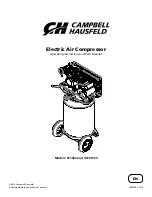
Sperre Air Compressor
Two stage, water cooled
Model: HV1/140A
All plain bearings are pressure lubricated.
After inspection or replacement of the big-end bearing it is important to ensure that the bearing
does not bind on the crankshaft. It must be possible to turn over the compressor manually.
New two-shell bearings are coated with a running-in compound at the factory.
Dismantling the gudgeon pin bearing from the connecting rod
A. Use a hydraulic pressor extractor to remove the old bearing shell.
B. Press in the new bearing shell.
C. Adjust the fit of the bearing to the gudgeon pin in accordance with Table T.4.
5.5. Piston and piston rings
Dismantle the piston as follows:
A. Remove the cylinder head without dismantling the valves.
B. Unscrew the big-end bearing bolts and remove the lower bearing shell.
C. Withdraw piston and connecting rod.
Reassemble in the opposite sequence.
5.6. Flexible coupling
The compressor flywheel serves as one coupling half.
Dismantling the coupling
A. Loosen the nuts on each coupling half and give each one a sharp tap with a hammer before
removing them completely. This will cause the bolts to loosen from their conical holes in the
coupling halves.
B. Remove the bolts and take out the flexible coupling. Avoid spilling oil on the flexible coupling.
The coupling half on the motor is keyed and shrunk on to the axle.
Alignment
The principle and values for checking alignment are shown in Fig. 4, page 32.
A. Micrometer/dial indicator
B. Magnetic base
C. Flywheel
D. Coupling half, motor
E. Flexible coupling
Check the angle (W) by means of inside micrometer callipers or vernier callipers. The distance
(W) in mm should be the same around the whole circumference of the coupling halves.
Check parallel misalignment (A) between coupling halves as shown, around the circumference of
the coupling halves (C). Values in mm for maximum parallel misalignment are given in Fig. 4.
5.7. Coolers
To ensure reliable operation of the compressor it is important to keep the LP and HP coolers free
from deposits of carbon and cooling water salts etc. Insufficient cooling causes excessive air
temperature and progressively increases the formation of carbon deposits.
The cooling tubes are rolled (or expanded) into the cylinder block at both ends. If the cooling tubes
show signs of severe corrosion or wear, the old tubes can be drilled out and new tubes rolled (or
expanded) in.
5.8. Filter
The air filter should be cleaned by means of a good degreasing agent. Blow the filter clean with
compressed air and give it a thin coating of compressor oil.
Oil filter: Clean with a good detergent and blow through with compressed air.
11/26
Summary of Contents for HV1/140A
Page 12: ...Sperre Air Compressor Two stage water cooled Model HV1 140A 6 ILLUSTRATIONS 12 26...
Page 13: ...Sperre Air Compressor Two stage water cooled Model HV1 140A 13 26...
Page 14: ...Sperre Air Compressor Two stage water cooled Model HV1 140A 14 26...
Page 23: ...Sperre Air Compressor Two stage water cooled Model HV1 140A 23 26...
Page 24: ...Sperre Air Compressor Two stage water cooled Model HV1 140A 24 26...
Page 25: ...Sperre Air Compressor Two stage water cooled Model HV1 140A 25 26...
Page 26: ...Sperre Air Compressor Two stage water cooled Model HV1 140A 26 26...












































